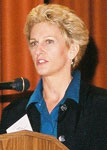
Pam Korza
Alex Parkinson, researcher for The Conference Board, urges in his blog post that arts and culture leaders need to become adept at demonstrating the social impact of the arts in terms that speak to corporate leaders. I agree! But, it’s not just about arts leaders building evaluation capacity. Social responsibility and impact starts with both cultural and corporate leaders defining clear intention and acknowledging that some shifts may be needed in defining the metrics that matter when assessing arts and corporate social responsibility investments.
Animating Democracy’s recently published Corporate Social Responsibility & the Arts report illustrates how corporations and corporate foundations are aligning business interests across a spectrum of positive social impacts to achieve the double bottom line of doing well and doing good. Many view conventional arts investments as achieving social good. For example, some believe the mere presence of strong cultural organizations is essential to a vital, healthy community. Many invest in youth development by making arts education and arts participation accessible to underserved youth, with outcomes such as greater confidence, civic as well as creative skill building, and work force development. Some corporations sponsor concerts and film festivals that deepen understanding and raise awareness on issues ranging from domestic violence to climate change.
Inherent in “social responsibility” are commitment and accountability. To effect the kind of “transformational” change on complex issues that Jana LaSorte talks about in her blog requires analysis of the issues, strategic approaches, and sustained support. One good example is Deutsche Bank Americas Foundation which takes an equitable community development approach to support small to mid-sized cultural organizations that are not as readily funded by other grantmakers and yet serve critical civic and cultural functions in disinvested neighborhoods. As Tia Powell Harris described in her blog about the Weeksville Heritage Center, Deutsche Bank’s support for the center has enabled visibility for and acknowledgement of African-American history that has been left out of the text books and the public sphere. A sensitized community can, we hope, better address present day inequities. Deutsche Bank works over time in partnership with its other grantees to understand each organization’s place in community and to translate grantees’ cultural assets into other social and civic benefits such as increased revenues for local businesses, improved education, and social cohesion.
What metrics matter in assessing social impact of corporate social responsibility investments?
A complicated question indeed, but why is that so? First, internally within corporations priority outcomes often vary across departments. While a CSR department may want to track social effects, a marketing department may aim for brand loyalty and human resources on employee retention and attracting talent. Second, like arts organizations, corporations find it challenging on several counts to measure the intangible effects of arts and culture or to isolate a cultural organization’s or project’s contribution to a goal such as neighborhood revitalization when so many other forces are at play. Formal evaluation typically requires skill and resources and often neither corporations nor arts and culture grantees have the capacity or can justify the expense. Corporate leaders interviewed for the Corporate Social Responsibility & the Arts study largely rely on grantees to develop metrics that are meaningful for the communities and populations they serve, although a few corporations implement their own evaluation to measure program outcomes. Kaiser Permanente’s Education Theatre Program administers a national survey in regions where it invests, to find out whether the health messages of ETP productions are reaching young audiences and being retained as a basis for positive behavior. Longitudinal studies, implemented with resources and professional evaluators, are most common for arts education or ongoing youth-based programs where fixed populations can be tracked over time, such as the Adobe Foundation’s Adobe Youth Voices program.

Infographic showing the social impact of Adobe Youth Voices program in 2013. Source: Adobe Corporate Responsibility Report, 2013
Philanthropy in general is beginning to acknowledge some needed changes in order to capture and understand the value add of art, as well as the community and social outcomes resulting from it. While return on investment (ROI) is still very much dictating metrics to gauge transactional effects such as increase in product purchase, or effectiveness of branding, there is a shift toward looking at “return on community,” i.e. outcomes such as community building, social cohesion, issue awareness, and civic participation. The interpretation of qualitative data into stories of transformation is increasingly acknowledged in the world of philanthropy as critical to both understanding and communicating impact. Storytelling and Social Change: A Strategy Guide for Grantmakers, offers examples of how funders are tapping the power of story to describe the human and social dimensions of change that are impossible to capture through numbers alone. Finally, new paradigms of success which allow for moments of “failure” are emerging. Alessandra DiGuisto of Deutsche Bank Americas Foundation underscores the importance of keeping the long view and a focus on lessons learned when a project may not produce the desired results. By working in close partnership with it grantees, such occasions can be kept in perspective and new strategies discussed.
When corporations and their arts partners and grantees have a genuine stake in social issues, social responsibility is everyone’s business. Both will need to work harder and together to define and track outcomes that matter toward the double bottom line of healthy society and business.






